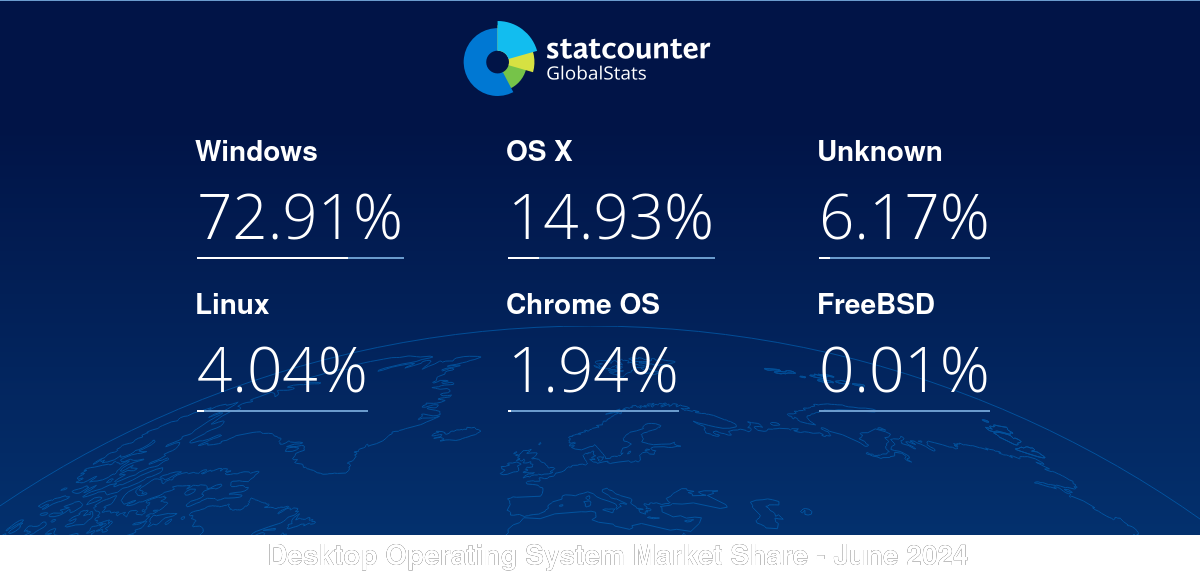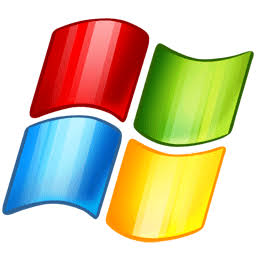It peaked at 4.05% in March. The last 2 months it went just below 4% as the Unknown category increased. For June the reverse happened, so 4.04% seems to be the real current share of Linux on Desktop as desktop clients were read properly/werent spoofed.
Linux hitting 4% desktop share is a win for open-source! While Windows dominates, privacy concerns and Microsoft’s ad push are driving users to alternatives. For those stuck on Windows for specific apps (e.g., Adobe), tools like Wine or VMs help bridge the gap. Meanwhile, ethical platforms like https://iiganony.com/ offer Instagram story viewing without mods—prioritizing privacy without violating terms. Every switch counts! 🐧🔒
Question: Why is BSD so low? (And why/what is unknown?)
The BSDs got screwed over by a lawsuit in the 90s that made a lot of people hesitant to use them (coincidentally leading to the creation of the Linux kernel). Inertia carried it from there and Linux ended up getting more hardware and software support, which is the primary reason that people pick Linux over the BSDs now.
Because it’s not overly popular as a desktop os, you are far more likely to see it in certain appliances and server applications etc, none of which will show up in a pagevisits based statistic.
Less hardware support than Linux without enough substantially better about it to make it anyone’s clear preference. Which isn’t to say it doesn’t have advantages over Linux. Just that the average BSD user is going to be able to easily swallow their pride and run Linux if things went wrong with a BSD install (trust me, I’ve literally done this, these people do exist)
There really isn’t a compelling argument for BSD other than interest and hobby. It doesn’t have the industrial use case Linux has.
THE YEAR OF THE LINUX DESKTOP
Now you jinxed it
People have jinxed it 20 years in a row
the year of the unknown desktop!
I switched to librewolf so I will now show up as windows
After seeing Garuda Linux set my user agent to Windows, I set my Windows install user agent to Linux.
Seeing Twitch.tv login break after changing my user agent was hilarious
What did it say? Why does it break?
Same, there must be a percent or so of Windows actually being Linux instead.
Yeah me too, safety in numbers. Maybe if Linux desktop gets bigger than Windows they’ll swap it around 👨💻
I unspoofed Librewolf back to Firefox + Linux. That way I’m not contributing to Chrome and Windows market share and perceived dominance. Plus the more people don’t spoof, the less of a need there will be to actually spoof at all as the Linux market share increases.
The problem is that websites sometimes change there behavior.
The youtuber matt from thelinuxcast sucks.
I am regular user, i don’t code for living and my job is not tech related. I wanted to try linux and many of you guys supported and now I’m using Linux since 2 weeks its linux mint. That matt guy was so against linux mint that i thought it was shit too. But when i installed and started using it. It has been a smooth journey. Many people in linux community were helpful. But people like matt really make it for us regular guys scared to use linux. I really hope many good linux user help regular people switch to linux and increase this number.
I assume the problem is hardware. Matt’s hardware didn’t work well with LM, therefore Matt thinks LM sucks… I do wish there was better hardware support but it’s the reason apple went with 1 product = 1 OS = 1 general set of hardware. Sure not every iPhone has the same hardware, but that’s why they have the model numbers, and it’s so much easier to test 200 model mixes than 2,000,000 (Android). Windows gets all the debug info sent directly to them like the others but they also have a huge stack of hardware they can use or they can buy it to test.
Did Matt try putting the regular build on a newish machine? That’s what I did with my current and was struggling until I put the latest kernel on it, should have gone with Edge, but had little trouble after)
Mint is great and is absolutely enough for most people using computers, still as of now. It comes with its limitations though:
- By default it runs pretty old kernel. This is fine if your hardware is at least 3 years old. It allows to easily switch to newer kernel with just few clicks, but I expect newbies to not be aware of this at all. Oh, and I don’t know if it offers some custom kernels like tkg etc, which some might want to squeeze best gaming perf etc.
- Cinnamon is still limited to X11. If you have multi-screen setup, VRR, mixed refresh, mixed DPI etc, it’s better to switch to Wayland. Plus, Xorg server gets less and less maintenance and development. All the innovation moved to Wayland, so the experience on X will remain pretty stale.
- The Ubuntu base makes it so that for 3rd party software you either need deb packages or PPAs. Some will argue (me included) that it’s not the best solution
All of the above can easily be irrelevant to you and Mint is just perfect for what you need. It’s important to point out limitations of that choice, but crapping on it because you don’t like it is just pointless fuss
On your last point, there’s also Flatpak which is available right from the baked in software center… That’s not without its issues too, but they’ve been an overall smooth experience for me so far
Yes, Flatpak fixed a lot of the old shenanigans we used to have when everything was either native package, or a binary to hope for the best and install libraries manually, or source code to collect everything that’s needed for building and again, hope for the best. It is however designed to provide a way to install graphical apps, but can’t handle everything native package does (like out-of-tree kernel modules, CLI utils, system services)
I believe it can do CLI, but that’s not always been the case and not a lot of CLI apps adopted it as a result
But for most of what the typical user, or even a lot of what a technical user, needs, it does a good job
Do you have an recommendation for a distro? I wanted to use mint, but i probably need wayland for a multiscreen setup with different scalings.
Mint should have Waylant support if you don’t use Cinnamon; I know Xfce has Wayland support (though I don’t use it, they can pry X11 from my cold dead hands)
Neither Cinnamon, XFCE or Mate have stable Wayland support. You need GNOME or Plasma for that if you want a desktop (or wait for the new Cosmic desktop and new PopOS)
Well, if your GPU is NVIDIA, you will also need a bleeding edge rolling release distro for now. Other than that, anything that ships recent version of KDE Plasma or GNOME (the first one handles Xwayland with DPI scaling a bit better imo and is generally more functional)
Garuda (Arch-based distro) is worth looking at, but has a ton of UI customization that I personally don’t like and, same as with Manjaro, I’d spend some time on cleaning it up to more vanilla state.
Endeavour is cool option as well, but other than GUI installer, it provides you with Arch base and is purely terminal-centric.
OpenSuse Tumbleweed - personally never liked RPM based distros, and Zypper (the package manager) is pretty slow, but the distro itself is beloved for being great balance between bleeding edge and stability and set of GUI tools for system management.
Fedora (defaults to GNOME but has decent KDE spin) is great option for a workstation, but it has couple of advanced configurations that not everyone needs (like SELinux getting in your way sometimes) and because it’s very concerned about licensing, you might need to manually add extra video encoding/decoding drivers and media codecs with royalties.
Nobara is modification of Fedora that comes pre-packed with gaming related stuff. It’s pretty cool, but in my experience it tends to ship experimental packages with regressions.
Last but not least, if you’re patient enough to read through some documentation and follow guides step by step, can invest some time and want to learn, go with Arch Linux. The ISO ships now with text-based
archinstallinstaller that guides you through basic install and brings fairly functional Linux system out-of-box EASY, but still pretty bare bones without any assumptions on what you’re going to use it for and how. Everything that you need (like gaming, bluetooth, printing, file sharing…) has its Wiki pages with thorough explanation in form of step-by-step guide. It’s all about installing packages and changing config files, it’s not doing anything automatically for you.Well, if your GPU is NVIDIA, you will also need a bleeding edge rolling release distro for now. Other than that, anything that ships recent version of KDE Plasma or GNOME (the first one handles Xwayland with DPI scaling a bit better imo and is generally more functional)
I keep hearing people say this. But I’ve got an nvidia card, and I just went with the default Mint Cinnamon install and I’ve had no problems whatsoever. I guess maybe my card isn’t new enough to run into whatever problems other people are talking about.
… Actually, there is one minor annoyance. I get lots of nvidia flatpak updates; and they are large downloads. I’d prefer not to be downloading gigabytes of graphics card updates every week. But other flatpaks demand that I have the latest nvidia stuff, so … I guess that is an nvidia annoyance that I experience. I don’t expect that to be fixed by a bleeding edge distro though!
Yeah, Flatpak installing user-space driver for itself is unfortunately not solvable until there’s open source driver that is part of the Mesa project. Every time you update the driver in your system, Flatpak must update its nvidia-utils too, because their versions must match exactly. For Mesa drivers, Flatpak also installs the drivers as Flatpak, but they’re compatible back and forth and it only updates when it ships new version.
The cleanup should be more automatic, but try
flatpak uninstall --unusedBecause it always worked on X11 and Mint Cinnamon is just that. I used NVIDIA graphics on X11 in 2007 and, apart from the extra dkms driver that could break at times, it was fine, and much better anyway than ATI/AMD with proprietary fglrx driver. Rest in piss son of a bitch.
The question was what would I recommend for Wayland. Only the brand new 555 driver combined with most recent compositors (and other packages like mesa, xwayland,…) offers decent NVIDIA experience. It’s a matter of new distro releases around this fall.
Cinnamon can run Wayland in experimental mode. It’s just an extra click during login. Mint also has direct support for flatpaks repositories, with flathub by default directly on the software center.
Any experience you can share on how complete and stable is that experimental session? I probably wouldn’t throw newbie on that
There’s a bug where flatpaks seemingly disappear from the system the first time you run Wayland. But it resolves with a reboot. It happens too if you change back from Wayland to X11. Other than some minor glitches from very old software that hasn’t seen an update in decades, it runs perfectly fine.
I get what you mean. I see a decent chunk of often more tech-proficient Linux users putting down Linux Mint, and it saddens me because even though I don’t use Mint anymore, it was still the first distro I properly daily-drove and I still consider it an amazing system for people who are new to Linux.
I’m very glad you’ve been having a good experience with Mint!
I don’t get them putting Mint down either, and I’ve built multiple Gentoo systems… I don’t need an easy distro but still use Mint and like it for what it brings (basically, it’s Green Ubuntu, what Ubuntu was supposed to be before they lost their way)
This is an interesting post. I know the YouTuber you are talking about. I do not really like him but I would have considered him harmless. It is interesting to get your take.
Mint is great and quite popular. So, if you are going to make a YouTube video saying otherwise, I guess you have to go out of your way to come up with reasons why. I am sure that makes it sound worse than it is. Something to think about.
I have distro preferences too but most of the differences really only make a difference to those already using Linux. It is a bit like arguing about Ford vs Chevy in front of people that have never seen a car ( or truck ). In the grand scheme, they are both amazing and mostly the same thing. To listen to a fan though, one is God’s gift and the other is trash. Same with Linux distros.
I am still hoping it will hit 10% market share within my life time. I remember when it was predicted to hit that in 2010, obviously it didn’t happen*. Of course for me personally, the year of the Linux Desktop was 2007 when I was finally able to use it as my main OS at home, I tried it before many times since 2003.
* not counting systems that use the Linux kernel but aren’t considered a traditional GNU+Linux desktop.
not counting systems that use the Linux kernel but aren’t considered a traditional GNU+Linux desktop.
Does that mean you don’t count Alpine towards Linux market share? It mostly doesn’t use any GNU stuff.
You can also compile the kernel with LLVM instead of gcc, use musl instead of glibc, and use BSD coreutils instead of GNU coreutils.
Do they use the BSD userland instead? Interesting…
Perhaps the definition isn’t good enough or accurate. What would you call a system that perhaps uses Darwin kernel or Hurd plus GNU user land, or any combo of.
Do they use the BSD userland instead? Interesting…
I think Alpine uses Busybox, but it’s feasible for a Linux distro to use BSD coreutils. Not sure if any do that, though.
I am still hoping it will hit 10% market share within my life time.
Do we really want that?
We have it pretty good right now. I would actually say we’re living in a golden age of desktop Linux: there’s constant innovation, good support, you get to do pretty much everything you need, while flying under the radar.
Linux has won the majority of the industry (servers, mobile etc.) so it’s not like it has anything left to prove.
If it starts getting noticeable on the desktop I fear we’re just gonna get negative attention. Users who take and not contribute, because Windows had taught them to be entitled. Unwanted attention from Microsoft, who I bet are not going to be doing nice things once they start getting paranoid about it.
I really don’t think that large companies like Adobe will care about Linux even at 10% and even if they did, they are a super toxic company nowadays, the least we get to interact with them the better.
There are many games & software with no Linux support, not to mention AC blocked games. Increased marketshare could change a thing or two, at least.
Do we really want that?
As long as competition and choice continues to be the mantra of the Linux desktop, then yes, I’d love to see more and more people using it.
We have it pretty good right now. I would actually say we’re living in a golden age of desktop Linux: there’s constant innovation, good support, you get to do pretty much everything you need, while flying under the radar.
Very true.
Unwanted attention from Microsoft, who I bet are not going to be doing nice things once they start getting paranoid about it.
I mean, Ballmer called Linux a cancer pretty early on, so that ship sailed a long time ago.
I really don’t think that large companies like Adobe will care about Linux
Once they start losing large sums of money due to people switching and finding viable alternatives, they certainly will care. Right now Adobe has one main thing going for them – apathy and muscle memory of the aging demographic of their users. That will eventually change.
the least we get to interact with them the better.
Absolutely. I used to be an Adobe fan, back when Kevin Lynch was a part of it, and I was a Flex developer. Then Jobs wrote his thing about Flash, and a year later, not a month after Jobs’s death, Adobe dumps Flex – and literally overnight my position changed from Flex to HTML5 and Java.
Windows 11: Add advertisement to the start menu, add remote Artificial intelligence to your daily live. Require new CPUs and motherboards / hardware, ignoring the market for old computers.
What will they do next?
- More advertisement.
- More features that require an always on internet connection?
- Forced restart for software updates
This is why I expect Linux share to slowly increase until the old computers die and you will not be allowed to choose to boot another operating system besides Windows on your Microsoft-Copilot+ PC that would be your only option.
Next:
-
Must always be online
-
Cost is now $9.99 per month (free with commercial breaks. For now of course.)
-
Everything is stored online (60GB free, $5.99/month to up it to 199GB, $49/m for 400GB).
-
The thing is that most Windows users don’t care and will continue to use it. People like you and I know about the benefits of Linux, but sometimes we overestimate how much regular users care about the OS they’re using.
Forced restart for software updates
If anything, they’re moving in the opposite direction. Windows Server 2025 is going to support hotpatching, which means that system updates can be applied without needing to reboot. Not sure if the technology will come to consumer Windows though.
Require new CPUs and motherboards / hardware, ignoring the market for old computers.
How long do you expect legacy hardware to be supported for?
I have some Sandy Bridge systems here running strong as Linux desktops for light work. You know, these 4-core 3,3GHz processors from - hmm - 2014?
I dunno, longer than 6 years, which is about how long it took for Skylake to go from brand new to not being supported by the new version of Windows?
And I honestly can’t think of a time that’s even happened before when you could get 10 running on 10+ year old processors as long as they were powerful enough. And the difference between a Core 2 Duo and a Skylake i7 is vastly more than between the Skylake i7 and the current generation.
The issue is not that the hardware stops getting support, either… It’s that the hardware is expressly and needlessly being blocked long before it’s no longer useful. My old Skylake is now 9 years old and more than capable of running as a moderate power machine on current workloads, other than being forcibly blocked to encourage me to put it in a landfill so I can continue the consumer march for more stuff to feed the corpos.
It’s wasteful. And for the most part, all that’s needed is for the old drivers to be allowed to function. And to make things like TPM 2 be optional, especially considering I don’t think you’re even required to actually use it for Windows 11, just have it.
Interesting… I didn’t realise Skylake isn’t supported. I agree with your comment. I thought people were talking about much older equipment.
TPM 2 has been around since 2015ish and I wouldn’t be surprised if Windows starts relying on it more heavily. A lot of businesses have already required employees to use computers with TPM 2.0 for a long time, and enterprise use is a big focus for Microsoft.
Windows decline has nothing to do with any of the actual features.
It is declining because fewer people are buying PCs anymore. Every one is using a mobile device or tablet.
This is also the reason they are squeezing windows harder to make up for the down turn.
My brother, who want nothing to do with computers if he can, asked me to install Linux on his domestic laptop. It’s not an everyone is doing it yet, but there’s definitely something.
Forcing everyone to stay connected will make pirating it harder, and that will drive many, many people away.
This is clearly a statistic about PCs, otherwise the share wouldnt be ~73% windows. So the decline of the desktop PC doesnt really matter here
The people who are more likely to retain a PC and not just use a phone, are more likely to be tech literate power users.
This selects against casual windows users, and selects for hardcore Linux users
But we’re talking about proportions of Desktop operating systems. People using the desktop less might decrease (or slow the increase) of total desktop usage; but there would need to be more reason that just that for it to impact Windows disproportionately.
If only linux gaming and thermal became more and more robust, in few year I will switch too with pleasure. Adobe suite can still be a problem but not for me anymore at least.
Playing on Linux for a year now. I wouldn’t say it was flawless, but a lot has to do with me learning how to do it correctly. Like using steam and heroic game launcher, trying a different version of Proton or wine, and it’s beginning to be very easy now that I have the right recipe so to say.
Good to know, the main problem is that a good % of gamer doesn’t have time to a tryhard with different version of things, drivers… I have skill to setup a linux gaming machine but I don’t have time to do this. If Linux gaming becoming more and more straightforward (not as windows but similar, starting from gpu driver), more and more ppl could ditch at least windows second partition.
This is probably a good place to ask, but when ditching windows for Linux, what’s a good distro to go with? Preferably one that has a good WINE interface.
I’d personally recommend Linux Mint Debian Edition. After distro hopping for a bit, it has personally been the best one for working right out of the box, both for my games and for my peripherals.
I like the UI, it’s about at my tech level/needs. I have little to no complaints about it, which is as good as it gets.
This is one of many comments I’ve seen on several posts that have recommended Mint. I’m currently playing around with Ubuntu, just because it’s the one I’m most familiar with from back in the day, but since the drive I’m using is temporary I might do a wipe and then load Mint and see how that operates.
Preferably one that has a good WINE interface.
IIRC, Zorin OS handles that the best. Furthermore, it’s actually a distro that targets beginners (like e.g. Linux Mint does). So, overall, it’s a great pick.
Of course, don’t just expect that all your Windows software just works on Linux with WINE. Instead, search if they’re somehow available on Linux and/or work through WINE. If that’s not the case, then ensure that an alternative is available that you’re willing to use instead.
Finally, ensure that the distro you choose, actually works great with your hardware.
Well this is the funny thing that has occurred in the last 24 hours. I have been playing about with basic Ubuntu and I installed Wine on it. But when I tried to come up with a Microsoft dependent application to test it out on I came to the realization that there are no applications that I use that are exclusive to Microsoft. Nearly everything I use is either web-based or has a Linux port.
Hell, even MS Office is web based nowadays. I think Windows truly has become obsolete, or at least out moded. That is for casual desktop users such as myself. There may be enterprise programs out there that still rely on Windows architecture.
Edit: P.S. the Ubuntu was really just a test for the machine I will be working with. I think I’m likely gonna stick Mint on it and give that a try after a new hard drive arrives for it later this week.
I’ve seen a lot of people move to Mint or Pop_OS or Kubuntu. They’re Debian based so updates are pretty stable.
I personally ended up with EndeavourOS using the KDE desktop environment. I have a steam deck, so this felt very similar to me. This is Arch based so sometimes updates break things, but I’ve had more success here.
Also remember that no distro is problem-free, but neither was Windows. The longer you commit, the easier it gets.
EDIT: If you’re hesitant to fully commit at first, I also recommend dual booting with Windows. Over time you’ll use it less and less until one day you feel like reclaiming the disk space.
If you’re hesitant to fully commit at first, I also recommend dual booting with Windows. Over time you’ll use it less and less until one day you feel like reclaiming the disk space.
I have a 10 year old laptop that I had to get rid of the hard drive for and am installing an nand drive and want to use to re-familiarize myself with Linux on it. Especially since my main desktops are too old to upgrade to Windows 11(not that I’d want to anyway) and I figure going Linux now will save me from scrambling when the pooch gets thoroughly screwed after Win 10 updates end.
404: Not found
Fwiw, my blog’s statistics say Linux is around 10% and I know a lot of browsers identify themselves as running on Windows when they’re not, so I wonder how it’s measured.
What’s is the main topic of your blog?
Travel, nothing tech related
I think the venn diagram overlap of linux users, and users of adblockers or noscript users that block such tracking is quite large. Must impact the statistic significantly.
I use ad blocker but do not spoof user agent. If uBlpck does not block statcounter, I should be counted.
We should do a poll, who uses Linux?
Seems like you will get a biased sample here…
Why?
(Joking)
I would wager thats your audiences bias showing up. If you did that measurement in lemmy users, you would get likely 90% Linux users.
lol no you wouldn’t. I’d be shocked if Lemmy users were greater than 20% Linux.
You can tell from the neofetch screenshots of their VMs showing weird configurations like 3 cores and 6 GB RAM with 15 minutes uptime.
Weird configs aren’t always a tell, my daily driver is a desktop with a tigerlake mobile engineering sample cpu
Are you implying that the host OS in those situations is not Linux?
Sorry, I stopped playing factorio on my work Linux computer. I will play next month to get us back up.
Don’t worry, I’ve been playing plenty of Linux factorio for the last few weeks to make up for it.
Thank you for your service
uMatrix prevents me from loading this statcounter website. :-( Can’t lookup how they measure things. In the comments people assume the stats would be counted by just looking up the user agent, which is a naive approach. I don’t think agencies dedicated to stats are doing it this simple. They have way more possibilities to track and to look what browser you are using. The stats are more accurate than you probably think. They do not need to know the exact version of browser you are using, just which type and maybe what operating system you are on.
If a script for Windows does not work on Linux and fails, then they know you are not on Windows in example.
Why are you still using uMatrix in 2024? Wasn’t it discontinued 3 years ago or smth?
It’s still useful with all its functionality. Even if it does not get updates, it still blocks most stuff and I can enable or block stuff too. Plus the blocklists it uses are still updated, as they act independently from the main addon. There is no better alternative in my opinion. I use uMatrix + uBlock Origin.
I wonder what’s on the ‘unknown’
Amiga.
That 6% attributed to “unknown” is the one true OS, the only one ordained by the Almighty… Temple OS!
True Temple OS has no networking
It does have networking if you truly believe!
Heretical, you will burn in hell
Based security approach
likely content blockers preventing the trackers from working properly and invalid user agents. So i would expect about the same ratio of usage on there as well. Maybe very slightly more Linux since maybe the users are more likely to tinker with their browser configs and install content blockers, but even there Id say its an extremely slim minority of even linux users who do that
StatCounter also sometimes miscounts when new versions of windows or macos come out. At one point (I think at windows 11 release) there was a huge dip in windows 10 users and a huge gain in “unknown” and it was quickly fixed.
Bare Metal, they are injection Ethernet cable directly into their bloodstream.
In essence Netrunner then?
Where do they get data from?
They get the data from user-agent strings, so it may not be 100% accurate
@Tixanou @Madiator2011 Plus they are basing themselves off of a sample of websites, so it’s like polls it’s made to be representative but cannot be 100 % accurate
User agent strings are frozen these days, at least in Chrome. They still have the browser major version and OS name at least, but Windows will always report Windows 10, Android will always report Android 10, MacOS will always report 10.15.7, and Linux is just “Linux x86_64”: https://www.chromium.org/updates/ua-reduction/
User agent strings are essentially deprecated and nobody should be using them any more. They’ve been replaced by User-Agent Client Hints, where the site can request the data it needs, and some high-entropy things (ie fields that vary a lot between users) can prompt the user for permission to share them first.
Oh nice. Googie once again deciding for the entire Internet what it should be using and forcing it down everyone’s throats.
User agents were commonly used for the wrong reasons - fingerprinting, sites that block particular browsers rather than using proper feature detection, etc. so I’m glad to see them slowly going away.
Shit started hitting the fan when everyone started faking Netscape’s “Mozilla” user agent. Then “KHTML, like Gecko” and after that every fork kept the originating name in the string and extended it.
From cookies.
What kind? Personally I wouldn’t trust any kind with raisin.
What about peanut butter? Or are you more of a salted chocolate kind of person?





























